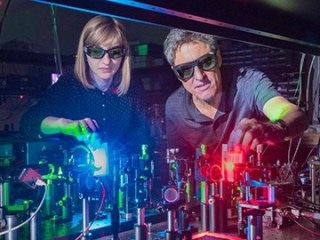Jul 10 2018
An optical frequency “metamixer” capable of changing two input laser pulses into output light waves in eleven separate colors, from the UV to the near-IR has been demonstrated by a team of scientists from the Sandia National Laboratories, USA, and Friedrich Schiller University Jena, Germany (Nat. Commun., doi: 10.1038/s41467-018-04944-9).
 Sandia postdoc and co-lead author Polina Vabishchevich (left) and team leader Igal Brener in the lab. [Image: Randy Montoya/Sandia National Laboratories]
Sandia postdoc and co-lead author Polina Vabishchevich (left) and team leader Igal Brener in the lab. [Image: Randy Montoya/Sandia National Laboratories]
The business end of the device is a gallium arsenide metasurface, meticulously designed to press into service seven individual nonlinear processes, ranging from second-harmonic generation to six-wave mixing, simultaneously.
The team still needs to work on improving the device’s output power and conversion efficiency. Still, the researchers are certain that with those enhancements, their ultracompact mixer platform could "enable a plethora of applications in biology, chemistry, sensing, communications, and quantum optics".
Current limitations
Frequency mixers are a central technology in radio-frequency communications, navigation and signal processing. They are also common at optical wavelengths, with application instances ranging from attosecond-pulse and supercontinuum generation to the lowly green laser pointer.
Usually, optical frequency mixers depend on nonlinear optical processes and use bulk birefringent crystals to accomplish the work. But mixers using these crystals can mostly produce only one new color of light at a specified moment, because efficient frequency conversion needs phase matching between the input and output frequencies inside the nonlinear medium. As a practical matter, that restricts conventional nonlinear optical mixers to a single nonlinear process at a time and to operate in a narrow bandwidth, with unreliable physical alignment of the nonlinear crystal needed to tweak output wavelengths.
Metasurfaces for multiple nonlinearities
The research team, headed by OSA Fellow Igal Brener at Sandia, aimed to develop a much more versatile mixer by exploiting the strengths of gallium arsenide, a material identified to possess large nonlinear coefficients. Specifically, they did an end run around the phase-matching requirement by designing the material at the nanoscale, where the tight confinement of light in subwavelength cavities can considerably improve field strengths. Those robust fields, in turn, permit efficient frequency conversion with less need for phase matching—and the potential to tap several nonlinear processes simultaneously.
To develop the platform, the scientists used electron-beam lithography and inductively coupled plasma etching to style a forest of 400-nm-diameter nanocylinders comprising three layers: a 300-nm-thick silicon-oxide etch mask at the top, a 400-nm-thick, low-refractive-index aluminum-gallium oxide layer at the bottom, and a 450-nm-thick gallium arsenide nanodisk in between. These nanocylinders were placed on a rectilinear array, with a separation distance of about 840 nm, atop a high-index layer of gallium arsenide.
From two wavelengths to eleven
With their sample ready, the scientists next fired two near-IR femtosecond laser beams instantaneously at the material—one with a wavelength of 1.24 µm, to overlap with the electric-dipole resonance, and one at 1.57 µm, near the metamaterial’s calculated magnetic-dipole resonance. They aimed the two beams on the same approximately three-micron-diameter spot and measured the resultant output signal with a liquid-nitrogen-cooled silicon camera fixed to a spectrometer.
The team’s experiments revealed that the metamixer surface converted the two IR pulses into output waves possessing eleven spectral peaks, ranging from 380 nm to 1000 nm. Numerical modeling showed that the eleven colors were produced by combinations of seven separate nonlinear processes: second-, third- and fourth-harmonic generation, two-photon absorption-induced photoluminescence, sum-frequency generation, and four- and six-wave mixing.
Broad application space
At present, the conversion efficiencies of the material are somewhat low—partly because most of the nonlinearly produced frequencies are above the gallium arsenide band gap and therefore are mostly absorbed by the material. The team is certain that it can improve those efficiencies by trying out larger-band-gap materials and by tuning the nanoresonator shapes, dimensions, and orientations.
As those efforts yield positive results, the team sees a wide application space for the ultracompact optical mixers that the work could facilitate. These could include the generation of higher-order harmonics for new methods to attosecond-pulse generation, laser sources for the mid-IR part of the spectrum, and compact light sources at definite wavelengths for remote sensing, biomedical imaging, communications and more.